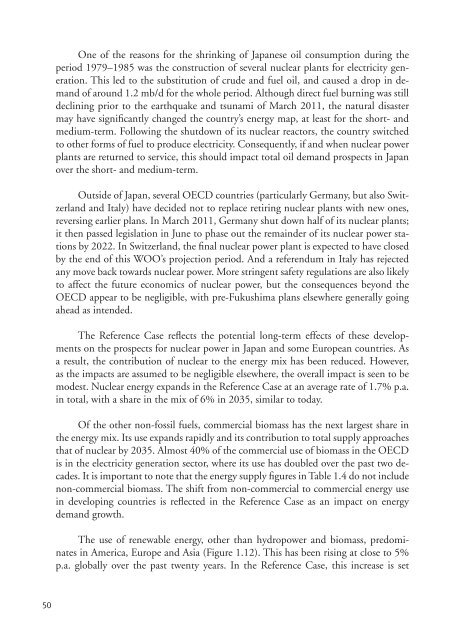World Oil Outlook - Opec
World Oil Outlook - Opec
World Oil Outlook - Opec
- TAGS
- world
- outlook
- opec
- www.opec.org
You also want an ePaper? Increase the reach of your titles
YUMPU automatically turns print PDFs into web optimized ePapers that Google loves.
50<br />
One of the reasons for the shrinking of Japanese oil consumption during the<br />
period 1979–1985 was the construction of several nuclear plants for electricity generation.<br />
This led to the substitution of crude and fuel oil, and caused a drop in demand<br />
of around 1.2 mb/d for the whole period. Although direct fuel burning was still<br />
declining prior to the earthquake and tsunami of March 2011, the natural disaster<br />
may have significantly changed the country’s energy map, at least for the short- and<br />
medium-term. Following the shutdown of its nuclear reactors, the country switched<br />
to other forms of fuel to produce electricity. Consequently, if and when nuclear power<br />
plants are returned to service, this should impact total oil demand prospects in Japan<br />
over the short- and medium-term.<br />
Outside of Japan, several OECD countries (particularly Germany, but also Switzerland<br />
and Italy) have decided not to replace retiring nuclear plants with new ones,<br />
reversing earlier plans. In March 2011, Germany shut down half of its nuclear plants;<br />
it then passed legislation in June to phase out the remainder of its nuclear power stations<br />
by 2022. In Switzerland, the final nuclear power plant is expected to have closed<br />
by the end of this WOO’s projection period. And a referendum in Italy has rejected<br />
any move back towards nuclear power. More stringent safety regulations are also likely<br />
to affect the future economics of nuclear power, but the consequences beyond the<br />
OECD appear to be negligible, with pre-Fukushima plans elsewhere generally going<br />
ahead as intended.<br />
The Reference Case reflects the potential long-term effects of these developments<br />
on the prospects for nuclear power in Japan and some European countries. As<br />
a result, the contribution of nuclear to the energy mix has been reduced. However,<br />
as the impacts are assumed to be negligible elsewhere, the overall impact is seen to be<br />
modest. Nuclear energy expands in the Reference Case at an average rate of 1.7% p.a.<br />
in total, with a share in the mix of 6% in 2035, similar to today.<br />
Of the other non-fossil fuels, commercial biomass has the next largest share in<br />
the energy mix. Its use expands rapidly and its contribution to total supply approaches<br />
that of nuclear by 2035. Almost 40% of the commercial use of biomass in the OECD<br />
is in the electricity generation sector, where its use has doubled over the past two decades.<br />
It is important to note that the energy supply figures in Table 1.4 do not include<br />
non-commercial biomass. The shift from non-commercial to commercial energy use<br />
in developing countries is reflected in the Reference Case as an impact on energy<br />
demand growth.<br />
The use of renewable energy, other than hydropower and biomass, predominates<br />
in America, Europe and Asia (Figure 1.12). This has been rising at close to 5%<br />
p.a. globally over the past twenty years. In the Reference Case, this increase is set
















